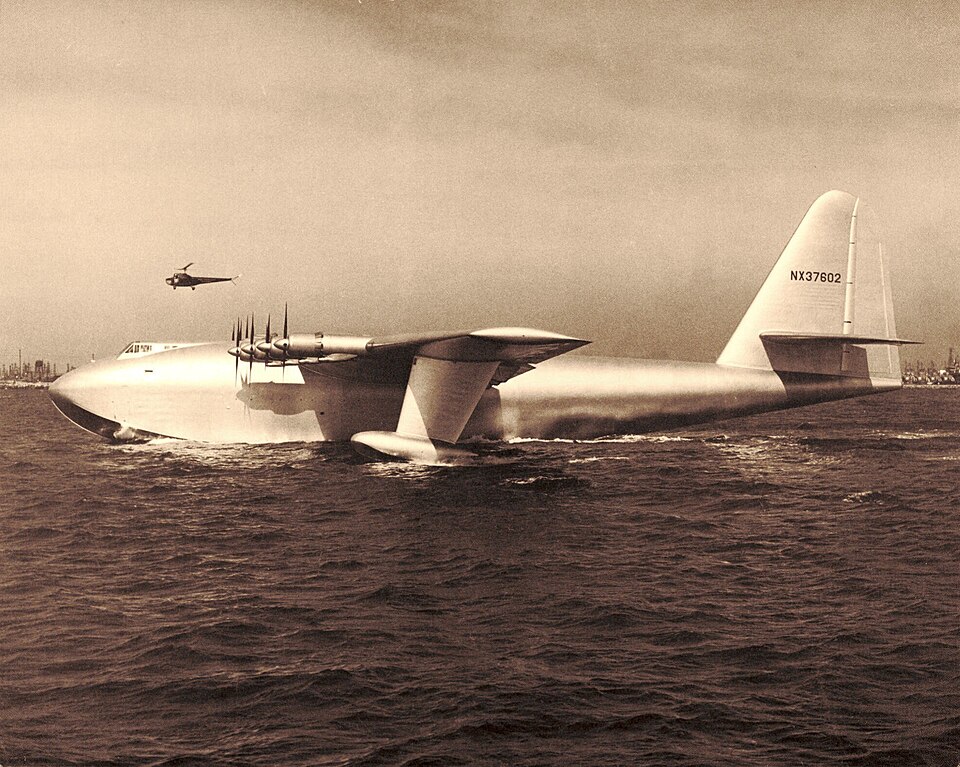
Why did the Spruce Goose only fly once? The Spruce Goose only flew once because the need for it had passed, it was too heavy, and Howard Hughes lost interest.
Spruce Goose was the nickname for the Hughes H-4 Hercules, a flying boat that was built to transport troops to Europe during the Second World War. At the beginning of the war. American ships were being rapidly sunk by German U-boats in the Atlantic and it was becoming difficult to get troops and supplies across to Europe. The idea was a giant transport plane that could carry a large number of soldiers and land on the sea, which became the Hughes H-4 Hercules. It was called the Spruce Goose because it was made out of wood owing to wartime restrictions on aluminium. Although, it was actually made mostly out of birch.
The Spruce Goose was built by the eccentric billionaire Howard Hughes, but he didn’t suggest it. He was approached by a steal magnate called Henry J. Kaiser. Kaiser was building ships that were rapidly being sunk and he thought that a fleet of planes that could safely cross the Atlantic would be a better idea. Hughes was involved in the aviation industry and Kaiser wanted to partner with him to create a plane the US government would buy. We have heard about Kaiser before. He was the man behind the rapidly built Liberty Ships. Kaiser and Hughes managed to get $18 million from the US government, which Hughes backed with a fair amount of his own money. And they set about to design a plane.
They received the contract in 1942 and Kaiser promised the prototype would be ready by 1943. They were hampered by wartime restrictions because they were not allowed to use any necessary materials, such as aluminium and steel, and they couldn’t use any people that were important to the war effort. Work began in 1942, but there were a lot of problems. Apart from the fact that they didn’t have any aluminium, Hughes was incredibly difficult to work with. He was undoubtedly a genius and a very talented engineer, but he was a micro manager, a perfectionist, and extremely eccentric. He often disappeared for long periods of time and work on the prototype would have to stop. By 1944, there was still no prototype and Kaiser was sick of the whole deal. He left Hughes to continue making the plane on his own. The first and only version of the Hughes H-4 Hercules was finished in 1947. The Battle for the Atlantic, which the plane was supposed to be a solution for, was effectively won in 1943, although there were still submarine attacks. And the war was also over by 1945. Hughes never gave up, though, and he saw the plane through to completion.
When it was finished, the Spruce Goose was a work of art and very ingenious, although highly impractical. It was built to carry 750 passengers, or two Sherman tanks. It was 66.65 m long and it had a wingspan of 97.51 m. That is 20 m longer than the wingspan of an Airbus 780 and 10 m longer than the Antonov An-225. It weighed 113 tons when empty and would have weighed a little over 200 tons when full. And, don’t forget, the plane was almost entirely made of wood. It was mostly made of something called Duramold, which was layers of birch sandwiched together with layers of waterproof resin and veneer. These could then be shaped. Hughes also had to design a hydraulic control system because the plane was bigger than anything that had been made to that point.
The plane was so far behind schedule that Howard Hughes was investigated by the Senate War Committee for misusing government funds. They found him innocent, but the consensus was that the plane would never be able to fly. That challenge appears to have lit a fire under Hughes and three months later, on November 2nd 1947, he was ready for the plane’s maiden flight. The only people inside were journalists, Hughes at the controls, and a copilot. In front of California’s Long Beach, Hughes did two practice runs. Most of the journalists got out at that point, thinking the plane would never fly. On the third run, Hughes gave it more power and it lifted off. He flew for 26 seconds, about 25 m above the sea, before landing again. The plane had flown. But that was it. It never flew again. The flight had proven that it could technically fly, but its enormous weight and the material it was made of meant that it would probably break up if flown for long distances and fully loaded. There was also no longer a need for it. After World War 2, there were no limits on aluminium and steel and new and larger transport planes were being produced. And finally, there was Hughes himself. He became more eccentric and more obsessed and less able to work on projects. He believed the plane could still fly and he had it housed in a hanger at the cost of about $1 million a year, but there was no way it would fly. And without Hughes to pilot it, no one else wanted to fly it. And that is what I learned today.
Sources
https://ig.space/commslink/the-spruce-goose-aka-h-4-hercules-a-successful-failure
https://en.wikipedia.org/wiki/Hughes_H-4_Hercules
https://en.wikipedia.org/wiki/Howard_Hughes
By SDASM Archives – image http://www.alaska.faa.gov/fai/afss/AcftPhoto-List.htmhttps://www.flickr.com/photos/49487266@N07/7881222436, Public Domain, https://commons.wikimedia.org/w/index.php?curid=33729
